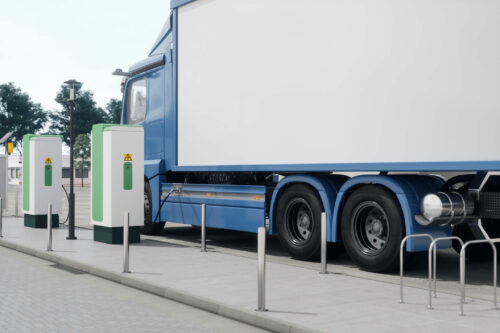Medium-and heavy-duty vehicles (MHDVs) are a key component of California’s freight ecosystem, which moves over 1.4 billion tons of goods annually. The San Francisco Bay Area holds particular prominence in these freight flows. The region is a key demand center, has the eighth largest container port in the country — the Port of Oakland, and includes key freight corridors such as I-80, I-580, I-680, I-880, and US – 101. Although MHDVs are essential in the distribution of goods to meet business and customer needs, their reliance on diesel fuel has serious environmental consequences due to increased pollution. This presents an urgent need to clean up these truck operations through electrification.
The Bay Area Medium and Heavy Vehicle Electrification Roadmap provides guidance for developing grid charging infrastructure development for return-to-depot, drayage, and long-haul operations to support trucking electrification in the region. It aims to support fleet transitions to electric MHDVs (E-MHDVs) while meeting operational needs, prompt utilities to plan for future power demand, guide charging infrastructure providers on where charging will be needed, and recommend actions for state and local governments to accelerate freight electrification.
The analysis evaluated the future power demands from E-MHDVs for varying duty cycles across two different electrification scenarios. Scenario 1 captures California’s policy goals at the time of the study. Scenario 2 assumes 100 percent of trucks operating in the region will be electric by 2050.
Projected power demand in the Bay Area from E-MHDVs
The study shows that total 2035 power demand from E-MHDVs in the region will grow to 390 MW in Scenario 1 and 580 MW in Scenario 2 at 5pm, when the grid experiences significant demand across the system. By 2050, peak power grows to 920 MW and 1,160 MW, respectively. The analysis suggests between $515 and $725 million will be needed through the end of 2050 to upgrade substations and circuits to accommodate E-MHDV growth only.
Ensuring the Bay Area is prepared to meet the future power needs from E-MHDVs requires three key activities:
-
Strategic siting of charging infrastructure: Identify and prioritize high-impact charging locations to maximize utilization, minimize costs, and support future scaling.
-
Strengthening the grid for rising power demand: Prepare the grid to handle significant future truck charging loads through grid assessments, advanced planning, and proactive investments, scaling flexible interconnection pathways.
-
Mechanisms to develop and scale charging infrastructure: Accelerate deployment of high-powered charging infrastructure by providing dedicated funding and incentives to offset equipment and site development costs, streamlining permitting and zoning and leveraging distributed energy resources and managed charging.
Finally, the report outlines short term- and long-term key action items for stakeholders to help accelerate freight electrification.

